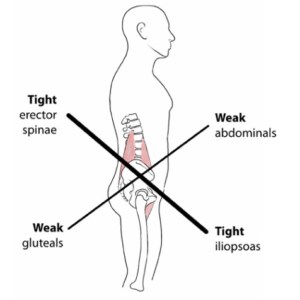The World Health Organization reports the lifetime prevalence of common low back pain to be 60-70% with a one year prevalence being as high as 15%-45% and peaking with adults ages 35 to 55. No matter the age, all are at risk for injuring their low back due to poor core stabilization and poor body mechanics. Both core stabilization and body mechanics play a big role in helping protect our low back with activity on a daily basis.
Core stabilization
 Core stabilization is a word we use a lot in physical therapy to describe the importance of the complex that lies within the core of each person. The picture shown here describes the most common findings through an evaluation of a poorly balanced system. When someone has weak abdominals (stomach muscles) and weak glutes (butt muscles) they also most commonly have tight erector spinae (low back muscles) and tight iliopsoas (hip flexor muscles). This pattern causes imbalances that add pull and strain to the low back with even very mild activity or lifting. The best way to fix this pattern is to strengthen what is weak and stretch what is tight. As a physical therapist, I work on this pattern correction with all my back patients to improve posture and control of the muscles. The most common mistake that I find is that people will strengthen their abdominal muscles but will neglect the other three areas which only causes continued strain in low back due to the weak glute muscles and tight hip flexor muscles.
Core stabilization is a word we use a lot in physical therapy to describe the importance of the complex that lies within the core of each person. The picture shown here describes the most common findings through an evaluation of a poorly balanced system. When someone has weak abdominals (stomach muscles) and weak glutes (butt muscles) they also most commonly have tight erector spinae (low back muscles) and tight iliopsoas (hip flexor muscles). This pattern causes imbalances that add pull and strain to the low back with even very mild activity or lifting. The best way to fix this pattern is to strengthen what is weak and stretch what is tight. As a physical therapist, I work on this pattern correction with all my back patients to improve posture and control of the muscles. The most common mistake that I find is that people will strengthen their abdominal muscles but will neglect the other three areas which only causes continued strain in low back due to the weak glute muscles and tight hip flexor muscles.
Body Mechanics
Everyone has heard the saying, “lift with your legs, not your back.” This is a common saying that has been spread to help with lifting mechanics and protecting the back with movement. Although this can be a good lesson to help ensure you are not overworking your back during lifting, it is not the only key to success with lifting. Going back to the picture shown, the hips are really the true key to proper lifting mechanics. If you have proper core stabilization with all four of these areas balanced correctly, then the mechanics of lifting become easier because you can use your abdominal muscles to protect your low back and your glute muscles (Gluteus Maximus being the largest muscle in the body) to help carry the load while lifting. This means you must squeeze your glutes with each movement involving lifting, pushing, or pulling. A trained professional is best at teaching how to perform specific tasks with proper mechanics but the following are some little tips that you can use while pushing, pulling, or lifting.
- Wide base of support – this will improve your ability to use your legs and glutes to support while lifting.
- Tighten your abdominal and glute muscles – abdominals and glutes are often weak, but the more you use them the stronger they will become. Continue to activate these muscles with all pushing, pulling, and lifting to lower the stress on the low back.
- Bend at your hips – Rather than bending at your back to lower yourself, attempt to bend at your hips instead. This will allow your back to stay in neutral (the safest position) while you perform activity. You should also be bending at your knees when lowering yourself. Make sure to protect your knees by keeping them behind your toes whenever possible.
- Utilize half-kneel position – Half kneel position when lowering yourself to ground can help protect the back. Due to the natural alignment of the spine and hips in this position, it allows the hips to move more and protect the low back at the same time.
Sarah Heinrich, Physical Therapist
Bowdle Healthcare Center
